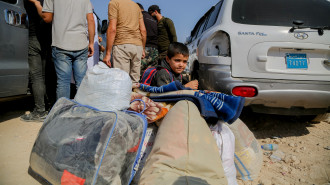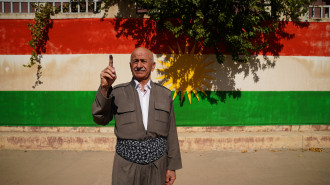Iran's nuclear deal 1: Arabs mustn't become collateral damage
This article is the first of a three-part series based on a lecture presented at the opening of a roundtable conference entitled "The Iranian Nuclear Agreement and Regional and International Implications" organised by the Arab Centre for Research and Policy Studies.
The deal and its historical context
We may consider the framework agreement concluded between Iran and the major powers (the five plus one - P5+1) to be the culmination of a process of historical regional and international transformation.
Internationally, the US has come to see clearly the limits of its empire, in terms of its ability to deploy forces and fight simultaneous wars in different parts of the world, and in terms of the effectiveness of military force in implementing what was designated, under the neo-conservatives, as the global defence of freedom - or what was designated in Iraq as "nation-building" in what was mockery of history soon followed by the irony of history.
| Regionally, a lot of blood has been spilled along the Nile, the Tigris, and the Euphrates. |
Since the time of Baker-Hamilton's Iraq Study group (ISG) and the appointment of Robert Gates as the US Defence Secretary during George W. Bush's second term in the White House, and throughout Barack Obama's second term, we have witnessed an internal reassessment carried out by the US political and security establishment.
This is in parallel with calls by liberal currents warning against the consequences of military interventions and their implications for the American people, currents that Barack Obama himself represents at this stage. The US administration is currently taking steps to end the siege on Myanmar (Burma) and Cuba, in addition the negotiations that could lead to lifting the sanctions on Iran. Clearly, there is a particular US approach in this regard then.
This transformation coincided with the rise of Russia from the ruins of the Soviet Union, as a strong nation-state promoting itself as the protector of the global nation-state-based order. Russia abandoned all ideologies and values in its foreign policy, regardless of the nature of these values, and could now only promote pure interest-based pragmatism disguised as the non-ideology championing the nation-state and sovereignty.
This manifested itself as an alliance of dictatorships against foreign intervention and against internal elements of instability, be these the result of democratic or terrorist movements. Both were seen as being the same thing for the Russian "neo-Westphalianists" and their principle of "subjects follow the sovereignty of their dictators" along the lines of the adage of "subjects follow the religion of their kings".
Regionally, a lot of blood has been spilled along the Nile, the Tigris, and the Euphrates. We spoke in the past about the unique nature of the rise of the Arab peoples as a power on the historical stage, demanding freedom, dignity, and democratic systems in a period where the US is opposed to exporting democracy and refrains from supporting those who demand it. These events exposed the brittleness of the Arab states, especially in those cases where states are little more than a thin crust for a social clique closely interconnected with the structure of the political regimes.
What concerns us now, in the context of regional transformations, is the Iranian expansion under US sanctions. Iran had recovered from the eight year war with Iraq, and went on the offensive through an intersection of objective interests with the US in Afghanistan in 2001 and in Iraq in 2003 (an intersection that has facilitated collusion). Iran exploited the predicament the US quickly found itself in after the occupation of Iraq, because of its failure to handle the complex political and social landscape of Iraq and crush the Iraqi resistance.
Expansion through sectarian influence
Iran consolidated its influence in neighbouring Arab nations by means of sectarian parties and through the rebuilding of the army and the security services, taking advantage of the sins of the US and its allies when they disbanded the Iraqi army and destroyed the entire state apparatus of the former regime. Iran entered Iraq through the doors opened by the occupation, the power vacuum and the sectarian incitement against the former regime.
In the context of its westward expansion, Iran took advantage of the animus the Arab peoples have for Israel, and infiltrated the Arab public opinion thanks to the vacuum left behind by the Arab regimes' abandonment of the Palestinian and Lebanese resistance. These Arab regimes focused instead on what they called the strategy of peace, beginning with the Camp David Accords and not ending with the Oslo Accords, the Wadi Arab Accords, and the Arab peace initiative that supplanted the Arab-Israeli conflict.
With the revolutionary rise of the Arab peoples in 2011, Iran did not side with the aspirations of the people, and instead exploited the fragility of the Arab states to further expand its influence.
The main problem here, for any Arab committed to the Arab identity, be he or she left wing, right wing, democratic, authoritarian, revolutionary, or conservative, is that Iran wagers on the weakness of the Arab regimes to forge bonds of direct loyalty with segments in Arab societies, and attempts to put together an alliance of minorities.
For any believer in Pan-Arabism, regardless of his or her ideology or religious beliefs, these actions help fragment not only the nation, but even local communities. This is something that Arab fragility cannot justify. No Arab in the past justified for the colonial powers their wager on the concerns of the minorities of all kinds and privileges, even when the Arab countries and societies had been in a worse condition.
On the other hand, the Arab countries that fear Iranian expansion is unable to put forward a project for a regional state or for cooperation among existing nation states to counter the Iranian project, not only externally, but also at the level of the cohesion of their societies and peoples. Such a project would combine development and citizens' rights, to pull the rug from under the feet of Iran's propaganda, and promote a principled position on the Palestinian question as an Arab issue rather than a burden that should be gotten rid of.
Iranian domestic politics
In Iran itself, the Iranian revolution met the same fate as many other revolutions. Oppositions emerged and established themselves from within the revolution itself, including a realist-pragmatic opposition, and fundamentalist-revolutionary oppositions holding on to what they perceive as the purity of the revolution in its beginnings. Some want to overcome that purity and move on to a new historical phase, while others combine different elements from all these oppositions.
Often, reducing these various contradictions into a struggle between hardliners and reformists leads to oversimplification and inaccuracy.
| Iran demands sanctions be lifted as soon as the agreement is signed, but the US says sanctions will be lifted after it verifies Iran's compliance. |
What is more important, in our view, are the existing contradictions in Iran between the religious state and the globally unique sectarian regime in Iran and the level of secularisation in Iranian society, especially in the cities; the contradiction between politicians and the clergy; and the contradiction between the ruling elite in general and the aspiration of urban middle-class youths, despite the complex structure of the regime and its ability to link broad segments of the people to itself based on their interests through hybrid popular-governmental organisations such as the Basij and the religious establishment.
As Iran sought to get the sanctions lifted, deal with internal economic challenges, find its place in the global economy and political order, and reach a framework agreement, Iran had to pledge to dismantle 13,000 centrifuges and operate only 5,060 centrifuges out of the remaining 19,000 for ten years. In total, Iran accepted to reduce uranium enrichment levels at its reactors to below 3.67 percent, and agreed to place its nuclear activities under strict international inspection regimes. Practically speaking, Iran ceded its sovereignty in all matters relating to its nuclear activities.
All this will ensure Iran is at least always one year away from manufacturing a nuclear weapon for the period of the agreement. The US promises itself that inspection and monitoring of the Iranian nuclear programme for 15 years will enable the US to control what will happen after that period as well. Iran will change as a result of this. More importantly, there is no alternative to negotiations and an agreement, and all these conclusions will be sealed if the final agreement is signed on June 30.
Iran demands that international and US sanctions imposed on it be lifted immediately after the agreement is signed. However, the US says the sanctions will be lifted after it verifies Iran has honoured the agreement, without explaining the mechanisms for this. In this regard, there is nothing clear and official yet, and each side is trying to emerge as the winner in the eyes of its own public's opinion.
This is an edited translation from our Arabic edition.

![Palestinians mourned the victims of an Israeli strike on Deir al-Balah [Getty]](/sites/default/files/styles/image_684x385/public/2024-11/GettyImages-2182362043.jpg?h=199d8c1f&itok=xSHZFbmc)


![The law could be enforced against teachers without prior notice [Getty]](/sites/default/files/styles/image_684x385/public/2178740715.jpeg?h=a5f2f23a&itok=hnqrCS4x)
 Follow the Middle East's top stories in English at The New Arab on Google News
Follow the Middle East's top stories in English at The New Arab on Google News


